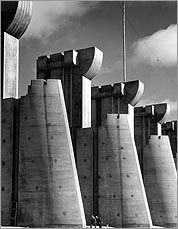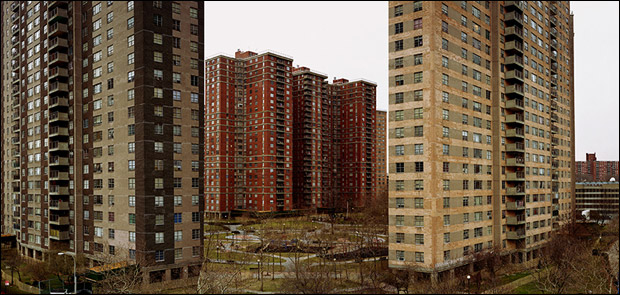And with the boom times gone, so are the Bilbao days, with Boston Globe architecture critic Robert Campbell swinging the reaper for the days of cartoonish show architecture.
With the election of the first "metropolitan" (i.e., not rural or exurban) president since Teddy Roosevelt, combined with his emphasis on rebuilding the bonds of community and on urban policy, there are great hopes for what may emerge from under the Obama administration. Congress, the states, and the president himself would do well to understand a few general trends and, er, hopes:
 1. Urban: As Blair Kamin of the Chicago Tribune writes, conversations about urban planning are taking place that are a level of magnitude more ambitious than anything that ever happened during the Bush years. At the same time, architects are scrambling toward urban planning and public projects and away from the Bilbao era's "icon" architecture.
1. Urban: As Blair Kamin of the Chicago Tribune writes, conversations about urban planning are taking place that are a level of magnitude more ambitious than anything that ever happened during the Bush years. At the same time, architects are scrambling toward urban planning and public projects and away from the Bilbao era's "icon" architecture.Amid that, there is a sense the city -- and urban planning -- are mounting a "return," with the inauguration festivities and the huge crowds they attracted onto Pierre L'Enfant's as evidence. That may or may not be very accurate reasoning (it sounds like excessive Obamamania-inspired exuberance, though the inauguration did make for one hell of a mob scene), but architects and planners are nonetheless alternately holding their breath and jockeying for funds to make cities vital and sustainable as never before.
There are calls for creating grand urban spaces that only central planning can do, like New York's grid or DC's Mall -- both of which were successful, but that sort of central planning has a sketchy record. Three simpler ways to advance urban planning are to focus construction of new buildings funded by the stimulus (schools, hospitals, government buildings) on dense urban areas; on urban infill (i.e., building on empty lots, like parking asphalts); and on brownfield development (renewing existing, unused buildings, rather than building anew). And new buildings outside of cities should be built as part of transit-oriented developments -- accessible by mass transit and embracing the urban principles of density and mixed-use.
2. Grand: Campbell of the Boston Globe fired an eloquent and perspective-filled volley across the new administration's bow last month when he called on any new public works programs to recall the days when America was still an up-and-coming power with a chip on its shoulder, as opposed to the more arrogant creature it's become on a governmental and collective level.
Before WWII, government at all levels in the United States built monumental, lasting structures that exuded a sense of pride and faith in classical democratic ideals. Afterward, government buildings became pared-down temples to the ordinary, as if embarrassed by their very existence. Think of any 1970s post office or school -- it's probably not only a depressing eyesore but falling apart. The 1990s saw a return of grand federal courthouses, but under George W. Bush
 (fittingly) government building projects were de-urbanized and moved to vanilla suburban sites deemed safer from terrorists; cookie-cutter and stripped-down Bauhaus designs were churned out; and the result was strip mall-esque structures like the new US Embassy in Berlin (left), which ignited much of Germany in anger against Washington for building such a hideous structure next to the Brandenburg Gate.
(fittingly) government building projects were de-urbanized and moved to vanilla suburban sites deemed safer from terrorists; cookie-cutter and stripped-down Bauhaus designs were churned out; and the result was strip mall-esque structures like the new US Embassy in Berlin (left), which ignited much of Germany in anger against Washington for building such a hideous structure next to the Brandenburg Gate.Campbell's words probably convey a warning as much as hope. Amid a general expectation that public works and other stimulus-propelled government spending will be the engine driving construction over the next few years, nobody knows what that new era of architecture will actually look like. Will it be grand, like the lasting bridges and buildings of the New Deal? Or will it be "value-engineered" to be as post-Gropius cheap as possible, similar to what characterized the last wave of government spending on buildings that stretched from 1946 with subsidized apartment projects for returning veterans to the 1970s and the Co-op City-style housing projects built across America's cities?
 Our Canadian friends, also expecting infrastructure spending to head off deepening recession, remind us that infrastructure isn't merely functional, as it was treated in the postwar 20th century. As North Americans on either side of the US-Canada border rediscover cities and urbanization, it makes sense to again embrace public works. Sewage facilities, water-treatment plants, electrical stations (or turbines) can all be made into elements of beautification and pleasure. They are powerful enough to either chase away existing residents and result in deadzones; or, if built with the timelessness and sturdiness as a WPA dam, they can lead to the creation of new, hip neighborhoods, spurring development and construction at a time when house prices desperately need a pick-me-up. What Bob Corker may call a "boondoggle" could be a great stimulus for the housing markets of Nashville or Memphis.
Our Canadian friends, also expecting infrastructure spending to head off deepening recession, remind us that infrastructure isn't merely functional, as it was treated in the postwar 20th century. As North Americans on either side of the US-Canada border rediscover cities and urbanization, it makes sense to again embrace public works. Sewage facilities, water-treatment plants, electrical stations (or turbines) can all be made into elements of beautification and pleasure. They are powerful enough to either chase away existing residents and result in deadzones; or, if built with the timelessness and sturdiness as a WPA dam, they can lead to the creation of new, hip neighborhoods, spurring development and construction at a time when house prices desperately need a pick-me-up. What Bob Corker may call a "boondoggle" could be a great stimulus for the housing markets of Nashville or Memphis.On the depressing topic of the Bob Corkers of the world, though, there are vocal critics in Congress of any spending that doesn't benefit their own district (they're generally called Republicans), which may mean our cities and landscapes will be scarred with more dollar-bin "tower-in-the-park" Bauhaus atrocities and housing projects. That may save a few billion dollars, but it arguably costs that many times over in damage done to quality of life and the built environment.
3. Traditional: If schools, government buildings and public works are going to be built, one of the most efficient -- temporally, environmentally and fiscally -- ways of doing so is to quit the Modernist cigarettes the world has been smoking since WWII and re-adopt traditional building techniques.
Locally sourced natural materials like brick, wood and stone; windows that actually open; courtyards; densely built streets. All of those traditional practices are cheaper and less energy-intensive than the modernism that has come to define most institutional buildings for the past half century. And, since the institutional buildings are often designed by committee and picked by committee, it may be no surprise that most people who use them don't really care for them.
 Research suggests more traditional proportions (e.g., a building that isn't a dark rectangular slab 2 blocks wide and 21 stories tall) have fractal patterns found in human features that are inherently pleasant to our eyes and minds; that may help explain why Americans overwhelmingly prefer older buildings to newer ones (amenities aside) and choose to live in faux Colonial houses.
Research suggests more traditional proportions (e.g., a building that isn't a dark rectangular slab 2 blocks wide and 21 stories tall) have fractal patterns found in human features that are inherently pleasant to our eyes and minds; that may help explain why Americans overwhelmingly prefer older buildings to newer ones (amenities aside) and choose to live in faux Colonial houses.But that shouldn't prevent tomorrow's WPA architects from creating their own aesthetic: Just as FDR's administration channeled money into a contemporary style with a solidly traditional basis (Art Deco), so might we see a new style emerge that picks up where Art Deco left off, allowing us to move beyond the fake Cape Cod houses but staying safely away from Zaha Hadid's latest mothership.
4. Coordinated: Finally, if billions of dollars is going to be dropped on infrastructure, it would pay to think about what it looks like and how it interplays with the people who use it, transportation systems, and other infrastructure before it's built.
 Sadly, as Russell argues, we can't even consider something like that today, so debased are our capabilities, expectations and (among Republican congresspeople) ability to plan for the long term. But if we're going to be building new schools, hospitals or government buildings, building them so in densely built neighborhoods and connecting them to the communities they're in via dedicated bus lanes or bike lanes planted with local vegetation could allow "mini Riverside Parks" to come about. What's clear is that the focus on costly, quality-of-life-killing highways and the dependence on elected officials in choosing projects are not going to help.
Sadly, as Russell argues, we can't even consider something like that today, so debased are our capabilities, expectations and (among Republican congresspeople) ability to plan for the long term. But if we're going to be building new schools, hospitals or government buildings, building them so in densely built neighborhoods and connecting them to the communities they're in via dedicated bus lanes or bike lanes planted with local vegetation could allow "mini Riverside Parks" to come about. What's clear is that the focus on costly, quality-of-life-killing highways and the dependence on elected officials in choosing projects are not going to help.A little sense in coordinating the various functions of a community when building public works goes a long way: Would Phoenix or Las Vegas be built today, starved as they are of any sustainable water source? Should money be thrown at draining the Colorado River to quench Vegas' thirst? (New motto: "What's drunk in Vegas, probably didn't come from Vegas.") Should stimulus money be used to rebuild a place like Galveston, TX, which will only be knocked down again in a matter of time, or flood-prone areas? Good coordination focuses on successful ideas and communities rather than throwing money at the poorly performing ones.
Perhaps by focusing on those broad principles we can overcome our terrible postwar track record. After all, if they could build Riverside Park when that was prime shanty-town real estate, what's preventing us from attempting something similar in other shanty-towns?





No comments:
Post a Comment